Surviving a Storm
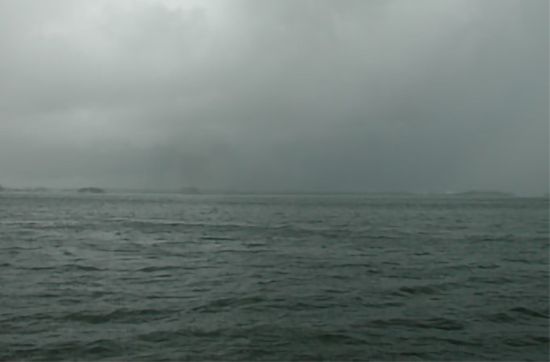
When running is not an option – Out on the water, when Mother Nature shakes a big stick at you there is no fight-or-flight response — it’s all flight. But this time, running wasn’t an option. There were half a dozen squalls bouncing around in the sky like it was a giant pinball machine of fury, shooting lightning bolts in every direction.
Meteorological snafu – There was no well-defined front, no common direction to the flow of the storms, and no logical organization. One storm went south at 20-mph while a storm right next to it shifted north at 30-mph. Some of the storms merged and ripped apart, then merged again.
From the helm – On my 24’ (7.3 m) center console, it looked completely bizarre, and very scary. It also made it impossible to run in a safe direction. There was none.
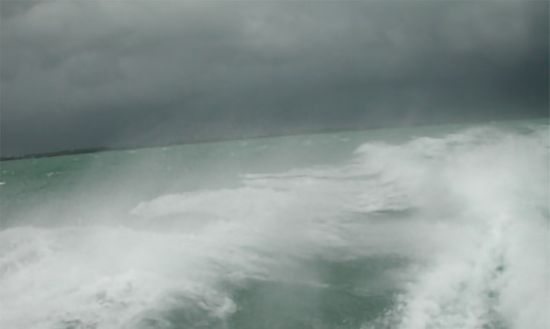
Quick action – I throttled up and got the nose of the boat pointed into the wind again. The waves built and in a matter of seconds, five to six-footers started slamming into us.
I gave the order – Lifejackets, for everyone. Then the lightning started raining down. It seemed to be everywhere, accompanied by ear-splitting thunder, so much that it seemed impossible to escape being struck.
Blinding rain – Then we were rammed by a wall of sideways-moving rain so thick I began to lose sight of the bow. When I tried peeking around the windscreen, the droplets were coming so fast that it felt like a thousand bees were stinging my face. With zero visibility, maintaining headway was going to be impossible.
Avoiding broaching – Keeping the bow into the waves would be imperative if we were going to stay afloat, so I told my mate to deploy the anchor along with every inch of rode in the locker.
Editor’s Note: It is important to understand that letting out all the rode allows for sufficient scope to keep the anchor from pulling the bow under a wave and swamping the boat. Also, know if and how the bitter-end of the rode is attached to the boat.

Riding it out – Once the hook grabbed and we jolted to a stop, we were at nature’s mercy. Huddling behind the console, three of us shivered in a drenched, scared misery. Thunderclaps, buffeting us without respite, were so loud that talking was nearly impossible. The waves topped eight feet, maybe 10, throwing the boat back and forth and yanking it violently against the anchor line. We could do nothing more than hold on, wait, and pray.
Powerless – We could do nothing as we felt the bolts holding down the bow chock rip through the fiberglass. We could do nothing as we saw the bow lights and a bow rail stanchion get sheared off by the anchor line. We could do nothing while the lightning’s intense heat shredded oxygen molecules into ions which re-formed into ozone molecules, filling the air with their eerie smell.
Twenty minutes later – The storms were racing off to threaten different people in a different boat in a different place. We were shaken, but fine. The storm damage that was done to my boat was minimal.

Seamanship or luck – A combination of both. When you hit the point at which your boat is being battered, thrown, and pounded so much that you realize you’re no longer in control — and your life is now in jeopardy — will you know how to survive?
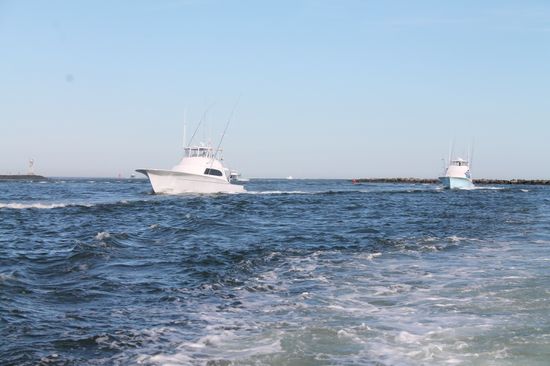
When and Where to Run
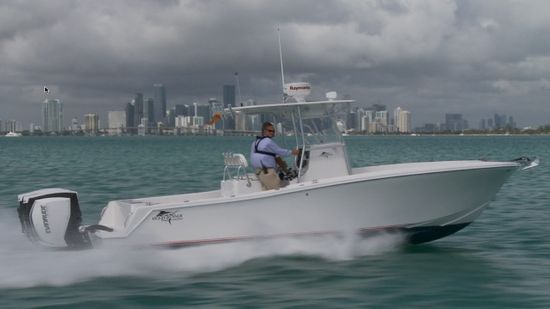
Radar is an advantage – Situations like the one described above are rare and usually you can avoid getting slammed. You’ll have an easier time of it if you have radar, which will allow you to see the storm coming and track its direction of progress.
Don’t hesitate – Remember, don’t wait until it’s right on top of you to start moving. When the edge of the storm is 10 miles away, you’ve already waited too long. Lightning can strike from as far as eight miles, and nearly 30-percent of all lightning strike victims report being under blue skies when the event occurred. So, get moving when the storm is still 10 to 15 miles in the distance.
Listen – You hear an unusual hissing sound? Check your VHF antennae, outriggers, and fishing rods that are pointing skyward. When one of these items starts cackling, you’re in serious trouble—static electricity in the air is reaching critical mass and lightning strikes are not far behind. Take down or lower the item(s) if possible and get out of there fast.

What to do if your boat is caught in a sudden storm – Make sure everyone onboard has a life jacket on before the going gets tougher. Prepare to idle at 45-degrees into the seas. Don’t even try to run once you’re in the storm. There’s no reason to since most squalls are isolated and blow past as quickly as they pop up.
It is assumed that your judgment is good enough that you’ll remain at the dock when a large, predictable storm is on the way.
Stay calm – Most of the time, you’ll only experience harsh conditions for a matter of minutes. Instead of rushing for port in the middle of them with reduced visibility, heavy seas, and course-altering gusts — use just enough power to hold your position.
If there’s time, secure your gear – Loose coolers, gear bags, fenders and the like can be expected to roll across the deck, fall off shelves, and generally cause havoc. Before the nasty stuff hits, secure everything you can. Do you have a heavy cooler or other weighty items? Tie them down aft, so they don’t weigh down the bow.
Check all hatches and ports – Be sure they’re properly dogged and watertight. Got any extra weight-creating cargo? This is a good time to get rid of it. Pump your bilges dry, drain the livewell and pump out melt-off in the fishboxes.
Note your position on the GPS – In case it becomes necessary to call for help, know your position. We’re talking latitude and longitude, not “sort of near the third red channel marker 20 minutes from the inlet.” Write it down on something so if your electronics get fried by a lightning blast, you still know your basic location.
Call for help – If conditions become extreme, call someone such as a friend, relative, or a dock hand at the marina and tell them your position and situation. Make arrangements to check in every 15 minutes and ask that they call the Coast Guard if you fail to check in at the appointed time.
In this day and age, there is absolutely no excuse not to have GPS on hand. In fact, there’s no excuse for not having a back-up unit, too.
Any port in a storm – What if you’re within a mile or two of land and visibility is good enough that you can make it? Then use that old adage, “any port in a storm.” If you can get to a pier — private or public — before the nasty stuff hits, do so. I’m a firm believer in the sanctity of other people’s property. But in this case, safety takes precedence over property rights. Tie off and head for cover.
If you lose power – If you can’t maintain headway, it’s imperative that you deploy an anchor or a sea anchor to keep the bow into the seas. In both cases, let out every inch of scope you have. No sea anchor or anchor aboard? A five-gallon bucket tied to a rope will work as a sea anchor for a small, open boat, in a pinch.
What Not To Do
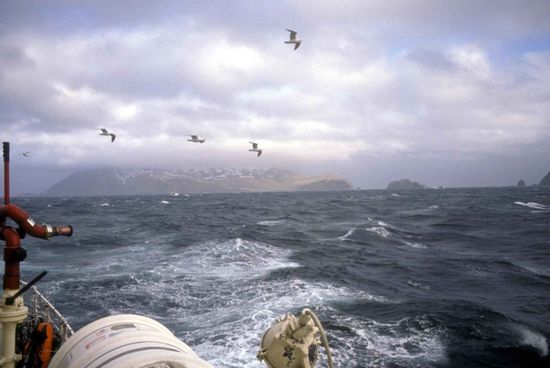
When you’re getting slammed – Never ever put up a full aft enclosure, especially on sterndrive and inboard boats. On any type of boat, a full enclosure is bound to restrict the already-poor visibility. It will act as a sail, making steering more difficult. Then, there’s the possibility that a strong gust will rip the enclosure open, and you’ll have flapping canvass and swinging aluminum struts adding to the mayhem.
The most significant reason not to put up an aft enclosure – An aft enclosure can trap fumes. Exhaust fumes may come up through a deck hatch, or thanks to the station-wagon effect, roll up and under the enclosure. This is a very real danger, especially on boats with engine hatches that aren’t airtight, including sterndrives and small inboards.
When to Run

Time to run – Running along the back of a wave is a tactic that is useful for running inlets or making way when an emergency requires you to run for the dock. This may increase the chances of shipping water because large waves can roll over the transom. It is difficult to maintain this approach for long periods of time. Eventually, the wave you’re riding will merge with another or sink below you into nothingness. Then, you’ll either be over the top and surfing out of control, or in the trough between two waves larger than your boat. Not good. Secondly, running with the seas will extend the amount of time you’re getting battered since you’ll be moving more or less with the storm’s direction of travel. Don’t fight the storm for any longer than you need to — whenever possible if Mother Nature starts waving that stick, it is time to run!